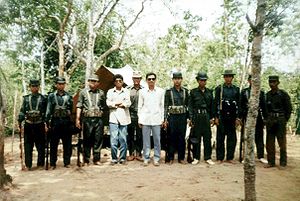
Back পার্বত্য চট্টগ্রাম সংঘাত Bengali/Bangla Conflicto en las colinas de Chittagong Spanish Konflik Jalur Bukit Chittagong ID 치타공 구릉지대 분쟁 Korean Conflito nas colinas de Chatigão Portuguese Конфликт в Читтагонгском горном районе Russian 吉大港山區衝突 Chinese
| Insurgency in the Chittagong Hill Tracts | |||||||
|---|---|---|---|---|---|---|---|
 Shanti Bahini insurgents, photographed on 5 May 1994. | |||||||
| |||||||
| Belligerents | |||||||
|
Supported by: | |||||||
| Commanders and leaders | |||||||
|
| |||||||
| Units involved | |||||||
| Paramilitary Forces:Law Enforcement: |
| ||||||
| Strength | |||||||
| |||||||
| Casualties and losses | |||||||
| First phrase: 6,000+ combatants killed (partial list)[5] | |||||||
|
3,500–25,000 civilians Total 30,000 Violent Deaths[6] 400+ conflict-related deaths from disease in Bangladesh (June-Aug 1995 only)[7]7,000+ non-violent deaths among refugees in India (May 14–21, 1990 only)[7] | |||||||
The Insurgency in the Chittagong Hill Tracts refers to a political and armed conflict that occurred in Bangladesh in two phases:
- First phase happened from 1977 to 1997 between the government of Bangladesh and the Parbatya Chattagram Jana Samhati Samiti (United People's Party of the Chittagong Hill Tracts) and its armed wing, the Shanti Bahini, over the issue of autonomy and the land rights of Jumma people, mainly for Chakma people and the other indigenous of Chittagong Hill Tracts. Shanti Bahini launched an insurgency against government forces in 1977, when the country was under military rule, and the conflict continued for twenty years until the government and the PCJSS signed the Chittagong Hill Tracts Peace Accord in 1997.[8][9][10][11][12]
- Second phase started in 2017 with the establishment of the secessionist Kuki-Chin National Front under Nathan Bom, which wanted to establish a separate state for the Bawm and other ethnic groups in the Bandarban & Rangamati district, and still ongoing.
The actions then carried out by the Armed Forces and the Parbatya Chattagram Jana Sanghati Samiti groups resulted in casualties on both sides.[13] There were also reports of mass rapes by the paramilitary Bangladesh Ansars, though these have been disputed.[14] According to Amnesty International as of June 2013 the Bangladeshi government made "praiseworthy progress" in implementing the terms of the peace accord and in addressing the Jumma people's concerns over the return of their land. Amnesty estimate that there are currently only 900 internally displaced Jumma families.[15][16]
- ^ a b Cite error: The named reference
nyt11Jun1989was invoked but never defined (see the help page). - ^ a b Dowlah, Caf (2013). "Jumma insurgency in Chittagong Hills Tracts: how serious is the threat to Bangladesh's national integration and what can be done?". Small Wars & Insurgencies. 24 (5): 775, 788–789. doi:10.1080/09592318.2013.866419. S2CID 144593890.
- ^ a b c Fortna, Virginia Page (2008). Does Peacekeeping Work?: Shaping Belligerents' Choices after Civil War. Princeton University Press. pp. 53–. ISBN 978-1-4008-3773-1.
- ^ a b c d Talukdar, S. P. (1988). The Chakmas, life and struggle. Delhi: Gian Pub. House. p. 52. ISBN 81-212-0212-4.
- ^ Bangladesh/Chakmas (1972-present)
- ^ a b The fragility of peace in the Chittagong Hill Tracts, Bangladesh
- ^ a b "Chronology for Chittagong Hill Tribes in Bangladesh", refworld.org, 2004
- ^ Rashiduzzaman, M. (July 1998). "Bangladesh's Chittagong Hill Tracts Peace Accord: Institutional Features and Strategic Concerns". Asian Survey. 38 (7). University of California Press: 653–70. doi:10.2307/2645754. JSTOR 2645754.
- ^ "Bangladesh peace treaty signed". BBC News. 2 December 1997. Retrieved 11 June 2008.
- ^ "Chittagong marks peace anniversary". BBC News. 2 December 1998. Retrieved 11 June 2008.
- ^ Mohsin, Amena (2012). "Chittagong Hill Tracts Peace Accord, 1997". In Islam, Sirajul; Jamal, Ahmed A. (eds.). Banglapedia: National Encyclopedia of Bangladesh (Second ed.). Asiatic Society of Bangladesh.
- ^ Ministry of Chittagong Hill Tracts Affairs Archived 8 July 2008 at the Wayback Machine
- ^ Cite error: The named reference
Begovich 2007 p165was invoked but never defined (see the help page). - ^ Cite error: The named reference
Jonassohn 1998 p258was invoked but never defined (see the help page). - ^ Cite error: The named reference
Amnesty International 2013was invoked but never defined (see the help page). - ^ Cite error: The named reference
Erueti ABC 2013was invoked but never defined (see the help page).
© MMXXIII Rich X Search. We shall prevail. All rights reserved. Rich X Search